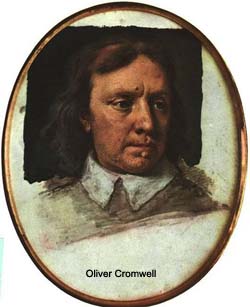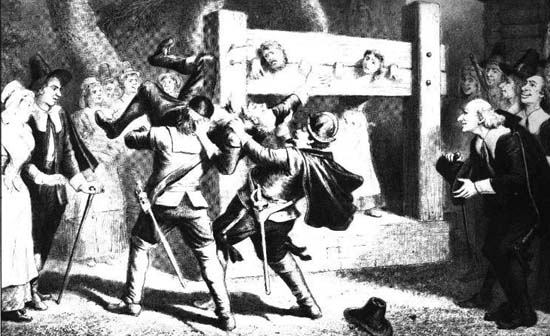The Puritan Ban on Christmas
by Martha Doe
In the mid-17th century, a wave of religious reform transformed
the way in which Christmas was celebrated in England. Oliver
Cromwell -- a statesman and General responsible for leading the
parliamentary army during the English Civil War -- took over
England in 1645. Supported by his Puritan forces, Cromwell
believed it was his mission to cleanse the country of decadence.
 In 1644 he enforced an Act of Parliament banning
Christmas celebrations. Christmas was regarded by the Puritans as
a wasteful festival that threatened core Christian beliefs.
Consequently, all activities relating to Christmas, including
attending mass, were forbidden. Not surprisingly, the ban was
hugely unpopular and many people continued to celebrate Christmas
secretly. In 1644 he enforced an Act of Parliament banning
Christmas celebrations. Christmas was regarded by the Puritans as
a wasteful festival that threatened core Christian beliefs.
Consequently, all activities relating to Christmas, including
attending mass, were forbidden. Not surprisingly, the ban was
hugely unpopular and many people continued to celebrate Christmas
secretly.
The Puritan War on Christmas lasted until 1660. Under the
Commonwealth, mince pies, holly and other popular customs fell
victim to the spirited Puritan attempt to eradicate every last
remnant of merrymaking during the Christmas period.
In the first half of the 17th century Christmas was an important
religious festival and a time when the English population would
indulge in a variety of traditional pastimes. The 25th December
was a public holiday, during which all places of work closed and
people attended special church services. The next eleven days
included additional masses, with businesses open sporadically and
for shorter hours than usual. During the twelve days of
Christmas, buildings were dressed with rosemary, holly and ivy
and families attended Christmas Day mass. As well as marking the
day's religious elements, there was also non-stop dancing,
singing, drinking, exchanging of presents and stage plays. The
population indulged in feasts of roast beef, plum porridge,
minced pies and special ale. Twelfth Night, the final day of
celebration, often saw a fresh bout of feasting and
carnivals.
It's no surprise that the daily celebrations often led to
drunkenness, promiscuity, gambling and other forms of excess.
Sixteenth and seventeenth century Puritans frowned on what they
saw as a frenzy of disorder and disturbance. In the Late 1500's,
Philip Stubbes, a strict protestant expressed the Puritan view in
his famed book The Anatomie of Abuses, when he noted:
'More mischief is that time committed than in all
the year besides ... What dicing and carding, what eating and
drinking, what banqueting and feasting is then used ... to the
great dishonour of God and the impoverishing of the realm.'
As well as disliking the waste and debauchery that went along
with the celebration of Christmas, the Puritans viewed the
festival (Christ's mass) as an unwanted remnant of the Roman
Catholic Church and, therefore, a tool of encouragement for the
dissentient community that remained in both England and Wales.
They argued that nowhere in the Bible had God called upon his
people to celebrate the nativity in this manner. They proposed a
stricter observance of Sundays, the Lord's Day, along with
banning the immoral celebration of Christmas -- as well as
Easter, Whitsun and saints' days. Preferring to call the period
Christ-tide, and thus removing the Catholic 'mass' element, the
Puritans reasoned that it should remain only as a day of fasting
and prayer.
 King Charles I
had largely supported the existing traditions and festivities
but, as control passed to the Long Parliament in the mid 1600's,
Parliament set in motion their idea of completely eradicating the
celebration of Christmas. King Charles I
had largely supported the existing traditions and festivities
but, as control passed to the Long Parliament in the mid 1600's,
Parliament set in motion their idea of completely eradicating the
celebration of Christmas.
Shortly before the Civil War had begun in January 1642, Charles I
had accorded Parliament's request to make the last Wednesday in
each month a day of fasting.
In January 1645 parliament enlisted the help of a group of
ministers to create a Directory of Public Worship establishing a
new organisation of the church and new forms of worship that were
to be adopted and followed in both England and Wales. According
to the Directory, the population was to strictly observe Sundays
as holy days and were not to recognise other festival days,
including Christmas, since they had no biblical justification.
Parliamentary legislation embraced the Directory of Public
Worship as the only legal form of worship allowed in England and
Wales. Two years later Parliament reinstated the law by passing
an Ordinance affirming the abolition of the feasts of Christmas,
Easter and Whitsun.
Oliver Cromwell regarded Charles I as an insurgent secret
Catholic who was subverting the Protestant faith. The Stuart King
was deposed and executed by Cromwell in 1649 and for the next
four years England was run by Parliament. But Cromwell had other
plans. He regarded the current system as ineffective and damaging
to the country. Supported by the army, on 20 April 1653 he led a
body of musketeers to Westminster and forcibly expelled
parliament. He then established himself as Lord Protector and
moved in to the Palace of Whitehall. The spectacular Banqueting
House is the only complete building of Whitehall to remain
standing to this day. The Palace was famously taken from Cardinal
Wolsey by Henry VIII and acted as the Royal residence until the
ascension of James I.
The Puritans believed that you would be welcomed in to heaven as
long as you worked hard in your lifetime, thus, enjoyment for
enjoyments sake was highly disapproved of. Cromwell ordered for
inns and playhouses to be shut down, most sports were banned and
those caught swearing would receive a fine. Women caught working
on the Sabbath could be put in the stocks. They had to wear a
long black dress, a white apron, a white headdress and no makeup.
The men had an equally sober appearance, dressed head to toe in
black and sporting short hair.

All shops and markets were to stay open throughout the 25th
December and anyone caught holding or attending a special
Christmas church service would suffer a penalty.
In the city of London things were even stricter as soldiers were
ordered to patrol the streets, seizing any food they discovered
was being prepared for a Christmas celebration.
Despite imposing such rigid measures on the common people, it
appears that Cromwell himself didn't quite live up to his
preaching. He liked music, playing bowls and hunting and, after
becoming Lord Protectorate, soon took to the high life. For his
daughter's wedding he even permitted a lavish feast and
entertainment fit for royalty.
In 1656 legislation was passed to ensure that Sundays were more
stringently observed as the Lord's Day and, thus, a day of rest.
The regular monthly fast day had always been hugely unpopular and
impossible to enforce and was subsequently dissolved.
Despite the threat of fines and punishment many people continued
to celebrate Christmas clandestinely. The ban had never been
popular and many people still held mass on the 25th December to
mark Christ's nativity also marked the day as a secular holiday.
In the late 1640s Cromwell tried to put a stop to these public
celebrations and force businesses to stay open. As a result,
violent encounters took place between supporters and opponents of
Christmas in many towns, including London, Canterbury and
Norwich.
Cromwell was Lord Protector until his death in 1658, whereby
Charles II was enthusiastically welcomed back to England to take
the throne as the country's rightful heir.
With the restoration of the monarchy in 1661, Oliver Cromwell was
once more a despised figure. Cromwell was originally buried with
great ceremony in Westminster Abbey, a famous gothic church in
London that houses the tombs of kings and queens dating back to
Edward the Confessor, as well as countless memorials to
distinguished English subjects. Upon taking the throne, one of
the King's first orders was to exhume Cromwell's lifeless body
and take it to be hung at Tyburn gallows, at the top of Hyde Park
near Marble Arch in London. This was the first permanent gallows
to be established in London in 1196 and was the main site for
public executions until 1783. This site is also famous because
105 Catholic martyrs were put to their deaths here from 1535 to
1681. A convent -- founded in 1901 -- now stands on the site, in
which around 20 nuns live and work. Visitors are welcome to visit
the church, which contains several Catholic relics.
Cromwell's body was decapitated and his head displayed at
Westminster Hall for over 20 years. Finished in 1099 this is the
oldest surviving section of the Palace of Westminster. The trials
of William Wallace, Sir Thomas More, Guy Fawkes and King Charles
I all took place here, so it was a fitting site at which to
display Cromwell's treacherous head. After changing hands over
the next three centuries, in 1960 Cromwell's head was finally
laid to rest at Sidney Sussex College, Cambridge, which he had
attended in 1616 to 1617.
Once Charles II was restored to the throne, all legislation
banning Christmas -- enforced from 1642 to 1660 -- was dropped
and the common people were once again allowed to mark the Twelve
Days of Christmas. Old traditions were revived with renewed
enthusiasm and Christmas was celebrated throughout the country as
both a religious and secular festival.
More Information:
We regret that we no longer have the resources to maintain up-to-date links and/or hours and pricing details for the various sites and attractions listed on this website. For more information about the location(s) listed above, please use your favorite search engine or visit Wikipedia.
Martha Doe contributes articles to a number of publications on
travel and history.
Article © 2005 Martha Doe
| 